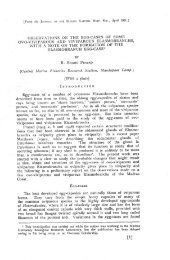PDF - Eprints@CMFRI
PDF - Eprints@CMFRI
PDF - Eprints@CMFRI
Create successful ePaper yourself
Turn your PDF publications into a flip-book with our unique Google optimized e-Paper software.
48<br />
fore seemed advisable to regard all as variations of one species , common to the Atlantic and Indo-Pacific<br />
Oceans".<br />
MARENZELLER (1901: 122) refused BROOK 'S " prekare Theorie der Ubiquitiit" and gave another<br />
interpretation in the description of his new species Acropora eminens (1906:56). He shared BROOK 's<br />
opinion that KLUNZINGE R's M. superba is M. muricata from the Westindies. He supposed that EHRE -<br />
BERG 's specimens of H. taxa were lost in course of time and only a label remained, which was placed on<br />
an Acropora where it does not belong. MARENZELLE R stated: " Durch diese Aufkliirung wird der Annahme,<br />
A. muricata lebe auch im Roten Meere, der Boden entzogen."<br />
We do not agree neither with MARENZELLER nor with BROOK, but rather suppose KLUNZINGER 's<br />
specimen of his M. superba comes really from Red Sea. After a comparision with other arborescent<br />
species we consider it as related to Acropora nobilis.<br />
Because the types of M. superba and H.laxa could not be found in the Museum at Berlin, the position<br />
of M. superba is still uncertain.<br />
Heteropora taxa 1834, EHR ENBERG , 334.<br />
Here we agree with BROOK and put this species provisionally to Acropora cervicornis.<br />
Genus Montipora de BLArNVILLE, 183 0<br />
Ty pes pee i e s: M01l!ipora verrucosa QUOY & GA IMARD , 1833.<br />
G e n e ric c h a r ae t e r s: Encrusting, massive, foliaceous or ramose. Axial corallite absent. Corallites<br />
more o r less I mm in diameter, fundamentally without elevated thecal wall . Septa in two cycles.<br />
A true columella absent.<br />
BERNARD (1897) arranged the 142 species dealt with by him under four major heads, based on the<br />
nature of the surface coenenchyme, as to glabrous, foveolate, papillate and tuberculate. Among these<br />
truly glabrous forms of Montipora are hitherto not recorded from Red Sea. The following is an artificial<br />
key to the 12 species of Montipo ra known from Red Sea and discussed herein .<br />
Synopsis of Montipora from Red Sea :<br />
A. Surface coenen chyme swells up either in the interstices or around the calices as ramparts or foveolations.<br />
I . Corallum encrusting or submassive. Calices 0.7 to I mm in diameter, surrounded by<br />
foveolations. Septa 12 .............. ... ... ... .. .. ..... . . .. .. . ..... M. veno sa<br />
B. Interstitial coenenchyme forms conical, nipple-shaped or rounded projections as papillae, which<br />
remain either single or run together.<br />
I. Corallum massive or encrusting. Surface with or without nodular coalescent branches.<br />
a) Papillae irregular, three or four fuse to fo rm excrescences.<br />
2. Individual papillae I to 1.5 mm thick and high. 3 to 5 papillae fuse to form small excrescences<br />
bearing calices; in between the coenenchym is smooth. Ca li ces 0.6 to 0.7 mm .<br />
.. . . .. . . .. . . . . .. . . . ' ... " ....... .. ... .... .... .. . .. ... .. . .... M. spumosa<br />
3. Papillae more or less I mm in height and thick. They fuse to form sharp crests. Interstices<br />
with flame -l ike small papillae. Calices average 0 .5 mm, inconspicuous. Surface without<br />
nodular branches ... . . .. . . ............... . ..... . . .... . .. ...... M. tuberculosa<br />
4 . Individual papillae 1 to 1.5 mm thick and 2 to 3 mm high. Often fuse to form ridges. Some<br />
areas with foveolations. Cal ices 0.6 to 0.7 mm, hidden from view .. .. ... M. monasteriata<br />
b) Papillae more regular, nipple-shaped or rounded with or without fusion fo rming ridges.<br />
5. Papillae nipple-shaped. Individual ones occupy the entire interstices. On branches, when<br />
developed, they unite to form ridges 2 to 3 mm high . Calices 0 .6 to 0.8 mm in diameter<br />
with a wall . Septa six ................ . .. ......... .. . ....... . .... M. verrucosa<br />
6. Papillae bursiform or rounded, 3 to 7 mm in diameter and height, often run together to<br />
form meand roid ridges. Calices very conspicuous, more or less 1 mm ..... M. meandrina
















